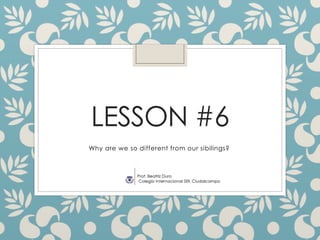
Lesson 6 meiosis
- 1. LESSON #6 Why are we so different from our sibilings?
- 3. GAMETOGENESIS ◦ Formation of gametes. ◦ Happens in the gonads. ◦ Basis of sexual reproduction Source: Bitesize BBC
- 4. Gametes ◦ Reproductive cells ◦ In humans: ◦ Male gamete: sperm ◦ Female gamete: ovum ◦ Characteristics ◦ One set of chromosomes only haploid cells In humans 23 chromosomes ◦ Formed in the gonads. ◦ A special diploid cell divides through a special process (meiosis) to produce 4 haploid cells which will differentiate into 4 gametes . Source: Scrape TV
- 5. Human karyotype Human karyotype: (somatic cell) ◦ Shows 23 pairs of chromosomes in total ◦ 22 pairs of autosomes and 1 pair of sex chromosomes. ◦ Sex chromosome pair can be: ◦ XX : in females ◦ XY: in males
- 6. Human Gamete karyotype Human gamete karyotype: Only has one set of chromosomes, one of each type. 23 chromosomes in total. ◦ 22 autosomes and 1 sex chromosome. ◦ Sperm may have sex chromosomes X or Y ◦ Ova can only carry the X chromosome.
- 7. DNA REPLICATION ◦ In order for gametes to form, the cell that is going to divide must have replicated DNA ◦ Replication takes place during Interphase (S phase)
- 8. MEIOSIS: 2 steps I. Reduction division2n n n n n n n II. Second division (mitotic division) 1 Diploid cell with Replicated DNA (chromosomes with sister chromatids) 2 Haploid cells with replicated DNA (chromosomes with sister chromatids) 4 Haploid cells (chromosomes with just one chromatid) Special cell in the gonad
- 9. MEIOSIS I: Reduction division ◦ Prophase I : homologous chromosomes pair up. Crossing over occurs. ◦ Metaphase I: homologous chromosomes line up in pairs in the equatorial plate. ◦ Anaphase I : homologous chromosomes separate and migrate to opposite poles of the cell. ◦ Telophase I: one chromosome of each type (with sister chromatids) reach opposite poles, nuclear envelopes form and therefore 2 haploid nuclei finish forming. Cytokinesis: the two haploid cells separate.
- 10. MEIOSIS I: Reduction division Prophase I: crossing over ◦ Homologous chromosomes pair up and swap different sections randomly crossing over ◦ Sister chromatids are no longer genetically identical. ◦ Increases variability of the species. ◦ Allows for the 4 gametes to end up carrying completely different combination of genes. ◦ That’s why 2 siblings (non-twins) are always different. ◦ The greater the variability, the greater opportunities of survival of the species.
- 11. MEIOSIS I : Reduction division Metaphase I ◦ Homologous pairs align in the equatorial plate. ◦ Spindle attaches to the kinetochore of each chromosome
- 12. MEIOSIS I : Reduction division Anaphase I ◦ Spindle contracts and shortens pulling homologous chromosomes apart. ◦ If homologous chromosomes travel to the same pole: monosomies or trisomies may occur.
- 13. MEIOSIS I: Reduction division Telophase I ◦ Chromosomes reach opposite poles. ◦ Nuclear envelopes form ◦ Two haploid nuclei are formed. ◦ Chromosomes still have 2 chromatids. ◦ There is only one chromosome of each type in the nuclei. ◦ Cleavage furrow appears for cytokinesis to take place.
- 14. MEIOSIS: 2 steps I. Reduction division2n n n n n n n II. Second division (mitotic division) 1 Diploid cell with Replicated DNA (chromosomes with sister chromatids) 2 Haploid cells with replicated DNA (chromosomes with sister chromatids) 4 Haploid cells (chromosomes with just one chromatid) Special cell in the gonad
- 15. MEIOSIS II: Second Division ◦ Happens in both haploid cells resulting from the reduction phase. ◦ Each of them go through 4 new phases of division. ◦ Prophase II: chromosomes coil. Mitotic spindle begins to appear. ◦ Metaphase II: Chromosomes line up in the equatorial plate. Spindle attaches to kinetochore on both chromatids. ◦ Anaphase II: Chromatids migrate to opposite poles ◦ Telophase II: Single chromatid chromosomes reach opposite poles. Nuclear envelope forms. Chromosomes uncoil. Nucleolus reappears. Two new haploid nuclei are formed ◦ This division is more like the mitotic division. ◦ Cytokinesis separates the cytoplasms. Two new haploid cells form. Each chromosome is made up of only 1 DNA molecule. ◦ All four cells, at the end of meiosis, have different combination of alleles.
- 16. MEIOSIS II: Second Division Prophase II Metaphase II ◦ Chromosomes coil. Mitotic spindle begins to appear. ◦ Chromosomes line up in the equatorial plate. Spindle attaches to kinetochore on both chromatids.
- 17. MEIOSIS II: Second Division Anaphase II Telophase II ◦ Chromatids migrate to opposite poles ◦ Single chromatid chromosomes reach opposite poles. Nuclear envelope forms. Chromosomes uncoil. Nucleolus reappears. Two new haploid nuclei are formed